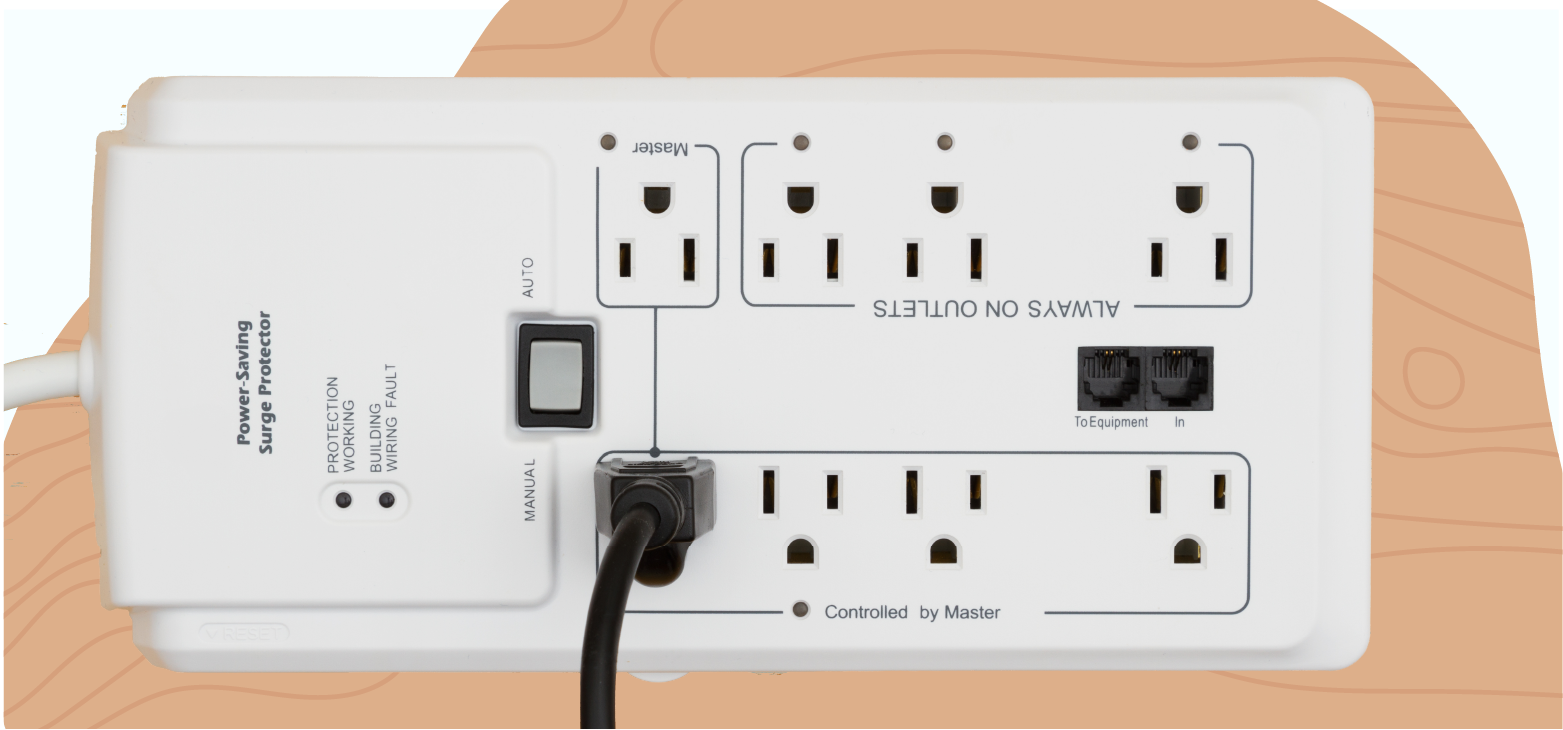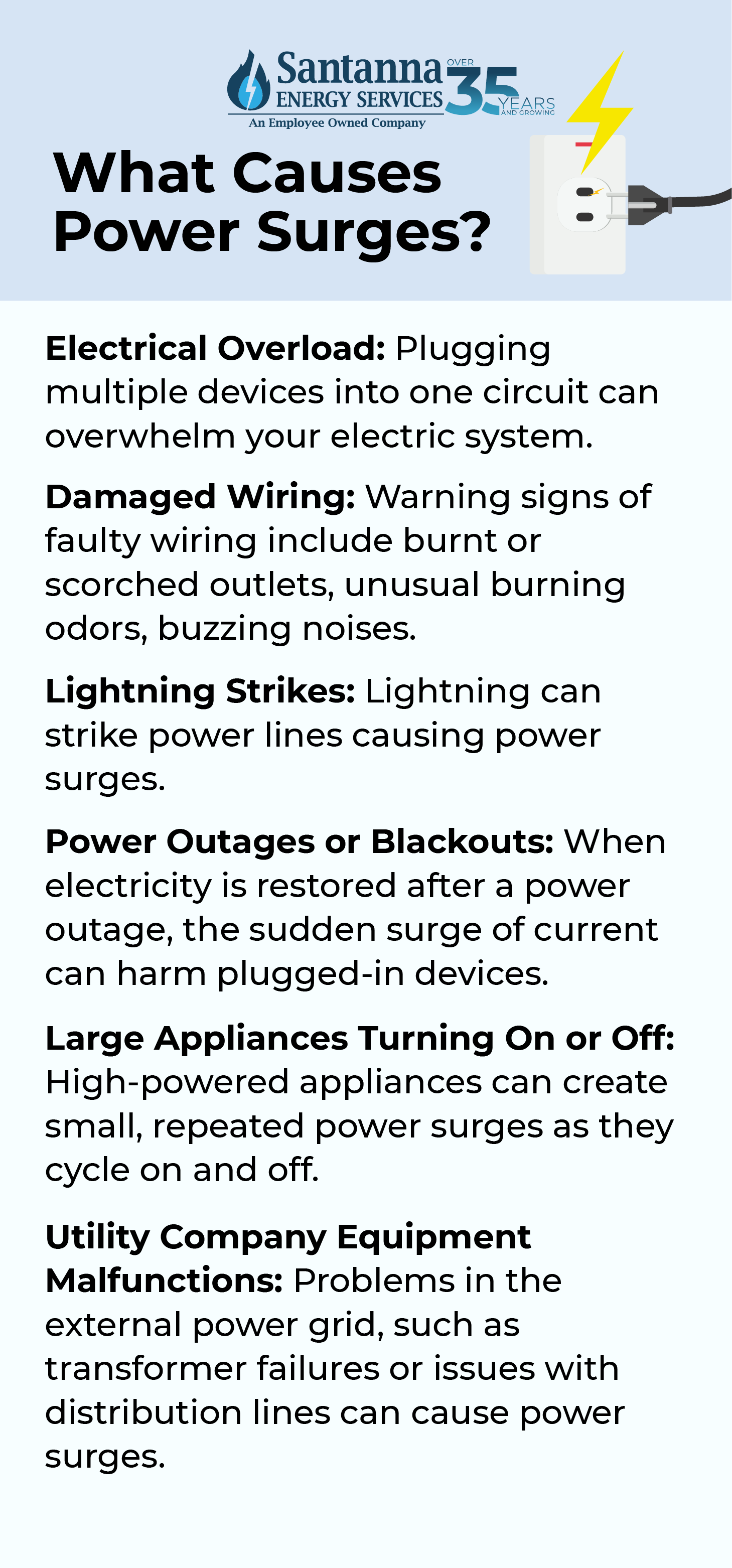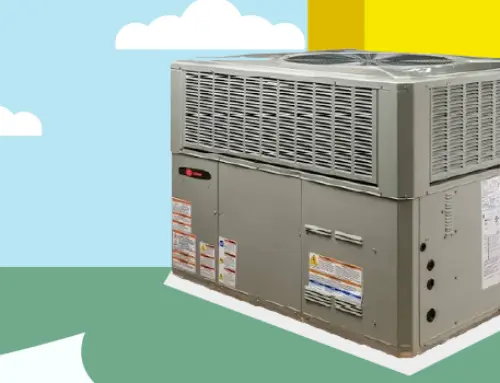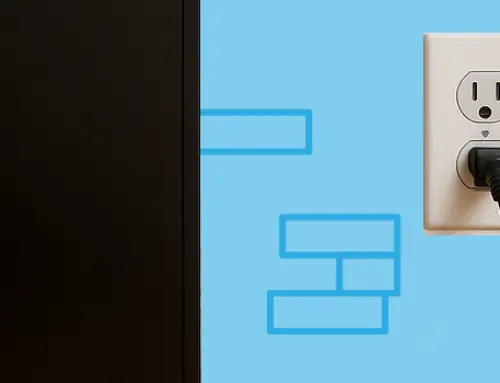What is a Power Surge?
by Tyler Castle
20.5 min read

Power surges are a common yet often misunderstood occurrence in modern households. They can damage your expensive electronics, disrupt your daily routine, and, in severe cases, even pose a fire hazard. But don’t worry—with a little knowledge and preparation, you can effectively protect your home and your gadgets from the impacts of power surges.
We’ll break down everything you need to know about power surges. We’ll explore what causes them, how they affect your appliances, and most importantly, the steps you can take to safeguard your home.
Let’s dive in and demystify the world of power surges, one surge at a time.
What Is a Power Surge?
Have you ever wondered: what is a power surge? A power surge, also known as a voltage spike, occurs when there is a sudden increase in electrical voltage flowing through your home’s electrical system and wiring.
Your home is designed to handle a standard voltage range of 120 and 240 volts called “nominal voltage,”. However, when a surge occurs, it can send thousands of volts surging through your circuits—far beyond what your appliances and electronics are built to handle.
This spike can last for just a fraction of a second, but that’s all it takes to potentially damage your electronics and appliances. It can fry circuit boards, degrade internal components over time, and even cause complete failure of sensitive devices like computers, televisions, and refrigerators.
What Causes Power Surges?
Power surges can occur for various reasons, impacting both your home and the devices within it. Understanding what causes power surges is crucial to protecting your electronics and ensuring your home’s electrical system functions reliably. Let’s explore some of the key reasons behind these disruptive events:

- Electrical Overload: One of the most common causes of power surges is an overloaded electrical outlet. When too much power is drawn from a single circuit, it can short out and cause a power surge. Overusing extension cords or plugging multiple devices into one circuit can overwhelm it leading to more severe power surges and damage.
- Damaged Wiring: Worn-out, damaged, or overheated wiring can cause power surges. Since most wiring is hidden behind walls, pinpointing the issue can be challenging. Warning signs of faulty wiring include burnt or scorched outlets, unusual burning odors, buzzing noises from electrical receptacles, and circuit breakers that trip repeatedly. If you suspect an issue, unplug devices and consult a certified electrician.
- Lightning Strikes: Lightning doesn’t usually damage devices through direct contact but can cause power surges by striking power lines. This generates a massive voltage spike that the electrical system cannot absorb, resulting in damage to appliances.
- Power Outages or Blackouts: When electricity is restored after a power outage, the sudden surge of current can harm plugged-in devices sometimes causing a power surge. This commonly occurs during large-scale power grid failures, making surge protectors essential to safeguard electronics.
- Large Appliances Turning On or Off: High-powered appliances, like air conditioners, refrigerators, or washing machines, can create small, repeated power surges as they cycle on and off. These surges are less dramatic but can gradually wear down sensitive electronics over time.
- Improper Electrical Repairs: Poorly executed electrical repairs or DIY fixes can lead to unstable connections, which may cause irregular power flow and cause power surges.
- Utility Company Equipment Malfunctions: Problems in the external power grid, such as transformer failures or issues with distribution lines, can send unexpected voltage surges into homes. In the same way, if your utility is in your area messing with power lines or electrical equipment, one small mistake to your electrical supply can cause a power surge.
- Downed Power Lines: Accidents or natural events that cause power lines to fall can lead to surges when the system attempts to stabilize. These events often produce unpredictable voltage fluctuations, posing a risk to connected devices.
- Old Wiring: Old wiring, especially in older homes, poses a significant risk as it deteriorates over time. Frayed insulation, loose connections, or corroded wires can create inconsistencies in voltage, which can cause power surges. If your home has outdated wiring, it’s essential to have a licensed electrician evaluate and update it to reduce the risks associated with power surges.
What Causes a Power Surge in a Neighborhood?
One of the most common places power surges can happen in your neighborhood. Power surges in a neighborhood can happen due to several factors:
- Lightening: When lightning hits power lines or transformers, it sends an excessive amount of voltage through the grid. With these high amounts of electricity striking the possibility of multiple power grids, mass power surges are more likely in a neighborhood.
- Downed Power Lines: Accidents or weather events that damage power lines can cause sudden voltage instability which can lead to power surges in a neighborhood.
- Utility Company Equipment Failures: Malfunctions in transformers, substations, or other utility infrastructure can lead to surges affecting multiple homes.
- High Demand on the Grid: During peak usage times, fluctuations in power distribution can result in minor surges across a neighborhood.
- Restoration After Outages: When power is restored after an outage, the sudden surge of electricity can cause voltage spikes.
How Often Do Power Surges Occur?
A harmful power surge typically occurs when the voltage exceeds 170 volts, which can overwhelm electrical systems and damage devices. Minor surges happen daily due to routine electrical activities, such as appliances cycling on and off. These events are usually harmless but can accumulate and degrade electronics over time.
Significant surges, caused by events like lightning strikes or utility grid malfunctions, are less frequent. Homes may go years without experiencing a major surge, but when they do, the results can be catastrophic. Lightning strikes, for example, can introduce thousands of volts into your electrical system, while faulty wiring or overloaded circuits can also lead to dangerous surges.
Causes of Power Surges Throughout the Seasons
Power surges can happen at any time and to anyone. But the reasons power surges can occur vary from season to season as different factors like temperature and weather conditions can contribute to the likelihood of power outages. Here’s what to keep an eye on if your home is prone to power surges:
Winter Season
Winter power surges occur due to a mix of weather conditions and increased energy demands during colder months. Low temperatures place extra stress on power systems, as heating appliances like furnaces, heaters, and heat pumps work harder to keep spaces warm. Every time these systems turn on, they can create brief voltage spikes, potentially leading to power surges that affect nearby equipment.
Additionally, winter weather events such as heavy snow, ice storms, and strong winds can damage power lines, causing outages. When power is restored, the sudden influx of electricity can cause power surges that overload devices or trigger system failures.
Summer Season
Summer power surges often result from increased electricity demand and extreme weather. High temperatures in the summer can lead to air conditioners running more often, straining the power grid. This demand can cause rolling blackouts or power surges when systems struggle to keep up or get overloaded. Storms, hurricanes, and other extreme weather events in summer can knock out power and cause power surges when electricity is restored.
Who Pays for Power Surge Damage?
Responsibility for power surge damage depends on the circumstances. If the surge is caused by utility equipment failure, your utility company may offer compensation. However, homeowners are generally responsible for power surge damage caused by internal issues, such as faulty wiring. To mitigate risks, consider installing surge protection and checking your homeowner’s insurance policy for coverage options.
Why Does My Power Keep Surging?
If your power keeps surging, it may indicate problems within your home’s electrical system or external factors. For instance, faulty wiring is one of the most common reasons your power keeps surging. Damaged or outdated wiring can create irregular power flow, leading to repeated surges.
In the same way, using too many devices on a single circuit can overwhelm it, causing frequent surges. Moreover, malfunctioning outlets could be a reason your power keeps surging, especially if its internal components are faulty. To avoid frequent surges, be sure to avoid plugging devices into these faulty outlets.
Another reason your power might be surging has to do with your appliances. Malfunctioning or high-power appliances like HVAC systems or refrigerators can cause localized surges when they cycle on and off. Lastly, external grid instability or electrical equipment failures can lead to recurring surges in your home.
How Resilient Is Your Outside AC Unit From Power Surges?
Because of their large capacity for energy usage, outside air conditioners are perhaps the most vulnerable to power surges. Power surges can damage vital parts like the compressor, capacitor, or control board, leading to costly repairs or complete replacement.
To improve the resilience of your outside AC unit from power surges start by using a dedicated surge protector for your AC unit to shield it from voltage spikes. If you can’t find a model that fits your needs, consider a whole surge protector. This adds a layer of protection to all appliances, including your AC unit.
To continue to protect your outside AC from power surges, regular maintenance is key. Ensure your AC unit is in top condition by scheduling regular professional inspections and replacing old parts before they wear out and become vulnerable. Lastly, if possible, turn off your AC unit during lightning storms to reduce the risk of damage.
What to Do if Your HVAC Control Panel or System Is Malfunctioning After a Power Surge
If your HVAC system starts acting up after a power surge, follow these steps:
- Turn Off Power: Immediately switch off the HVAC system at the breaker to prevent further damage.
- Inspect for Visible Damage: Look for signs of burnt components, tripped breakers, or unusual smells.
- Check the Thermostat: Ensure the thermostat is functioning correctly and reset it if necessary.
- Contact a Professional: Call an HVAC technician to assess and repair the damage. Avoid attempting complex repairs yourself.
- Consider Adding Protection: After repairs, install surge protection to prevent future issues like repeated damage, system downtime, additional repair costs, and potential device failures.
Can a Power Surge Damage a PC?
A power surge can damage a PC. Computers are particularly sensitive to voltage spikes because of their intricate internal components and reliance on consistent power.
Power surges can cause significant damage to your PC’s power supply units (PSUs). A PSU, or Power Supply Unit, is the component in your PC that powers everything. If you have an outdated PCU or leave your computer plugged into your charger on a regular basis, a power surge can overload the PSU, causing it to short-circuit, overheat, or fail completely. This can lead to system crashes, data loss, or even permanent damage to your motherboard, hard drive, or SSD.
Components like the CPU and graphics card are highly sensitive to electrical fluctuations. A surge can cause them to malfunction or fail entirely leading to data loss or a broken device. Devices connected to the PC, such as monitors, external drives, or printers, can also be affected by a surge.
Since a power surge can damage your PC, to protect your device, consider investing in a high-quality surge protector with a high joule rating. Joule rating represents the amount of energy the protector can absorb during a surge. The higher the rating, the better the protection.
As an alternative to a surge protector, consider a UPS. A UPS provides backup power and protects your PC from surges and power outages, allowing you to save work and safely shut down during interruptions. As another safety measure to protect your PC from power surges, if a lightning storm is imminent, unplugging your PC and other devices is the safest option.
Can Power Surges Cause Electrical Problems?
The short answer is, yes, power surges can lead to a variety of electrical problems, both immediately and over time. The sudden spike in voltage can disrupt the normal operation of your home’s electrical system and the devices connected to it.
For starters, a power surge can overload and damage the wiring in your home, potentially leading to short circuits or electrical fires. Even minor surges can cause cumulative damage to appliances, shortening their lifespan by wearing down internal components.
Electronics such as TVs, microwaves, and gaming consoles may begin to malfunction or fail entirely due to damaged circuits or processors from power surges. These malfunctions can last throughout the duration of the lives of these devices.
Also frustrating, power surges can trip circuit breakers or blow fuses, leading to sudden power loss in parts of your home. Another electrical problem caused by power surges is reduced energy efficiency. A compromised electrical system may struggle to deliver power efficiently, leading to increased energy consumption and higher bills.
Sometimes, the effects of a power surge are not immediately noticeable. Internal components in devices may weaken, leading to unexpected failures later. For example, a surge may damage the capacitors in your TV or motherboard, causing the device to stop working weeks or months later.
What Are the Signs of a Coming Power Surge?
While most power surges occur without warning, certain signs may indicate a higher likelihood that a power surge is coming:
- Flickering Lights: If your lights flicker or dim frequently, it could signal an unstable electrical system prone to surges.
- Buzzing or Humming Sounds: Unusual noises coming from outlets, switches, or wiring might suggest electrical instability.
- Burning Smell: A faint or strong burning odor near outlets or appliances could indicate overheated circuits, which are susceptible to surges.
- Frequent Circuit Breaker Trips: If your breaker trips often, it might be struggling to handle fluctuations, making your system vulnerable.
- Unexplained Device Malfunctions: Electronics that suddenly shut off, reset, or behave erratically could be experiencing small surges.
- Heat or Warmth Around Outlets: If outlets or plugs feel warm to the touch, it could signal overloaded circuits or electrical faults that might lead to surges.
- Unusual Behavior in Appliances: Appliances running louder than normal, lights dimming when they turn on, or inconsistent performance can indicate electrical instability.
- Surge Protector Indicators: Many modern surge protectors have indicator lights that show if they’ve absorbed a surge. Regularly check these to monitor your home’s surge activity.
How Can Power Surges Be Prevented?
Preventing power surges involves a combination of proactive measures and the right equipment to safeguard your home. You can prevent power surges by distributing high-power appliances across different circuits and avoid using too many devices on a single outlet or power strip. This helps reduce the risk of overloading your electrical system.
Additionally, having a licensed electrician inspects and upgrades old or damaged wiring to reduce the risk of power surges caused by faulty electrical systems.
For sensitive electronics, such as computers, televisions, and other appliances that contain microprocessors, consider using voltage regulators to maintain consistent power levels of 120 volts. Take note that surge protectors are different from voltage regulators. A voltage regulator shields delicate circuits by managing voltage levels. It monitors the power supply and shuts it off if fluctuations are detected, preventing sudden or long-term damage to connected devices.
For further prevention from power surges, inspect your home’s electrical system periodically to identify potential vulnerabilities, such as worn-out outlets or circuit breakers. Be sure to keep an eye on high-powered appliances, like HVAC systems and refrigerators, as they can create internal surges.
How to Prevent Damage During a Power Surge
One of the best ways to prevent damage during a power surge is to invest in a high-quality surge protector. Use point-of-use surge protectors for individual devices, such as desktop computers, laptops, TVs, gaming consoles, routers, and smart devices. Surge protectors can also safeguard home office equipment, smartphone chargers, and essential medical devices, making them crucial for both convenience and safety.
For lots of protection against power surges, check to make sure your surge protector has a high joule rating and meets industry standards. A “good” joule rating depends on the type of device you’re protecting. For small devices like lamps and clocks, a rating of around 500 joules is sufficient. Higher-powered devices such as laptops and smartphones need at least 1,000 joules, while larger electronics like gaming consoles or desktop computers require 2,000 joules or more.
What to Look For When Buying Power Surge Protector
Not all power surge protectors are created equal and choosing the right one can make a big difference in protecting your valuable electronics. With various options available, it’s important to know what features to look for to ensure maximum protection.
Warranties and Connected Equipment Insurance
If the surge protector stops working after protecting your devices, you can often get a replacement through the warranty. Some surge protectors even come with insurance to replace any gadgets they failed to protect. Make sure the insurance covers the cost of all the devices you’ll plug in.
It’s Joule Rating
A surge protector’s joule rating tells you how much energy the surge protector can handle. The higher the joule rating, the more protection it offers.
For essential devices, aim for at least 600 joules, and for high-end electronics, look for surge protectors rated 2000 joules or higher. Ensure it also has a fast response time to handle surges effectively.
The Number of Outlets You Have
Count how many devices you plan to plug in and make sure the surge protector has enough outlets. For small surge protectors, these offer 4-6 outlets, ideal for personal workstations or small devices like laptops and chargers. For standard surge protectors, commonly provide 6-12 outlets, suitable for home offices or entertainment systems.
For high-capacity surge protectors which are designed for larger setups, these can feature 12-24 outlets, often used in professional offices or industrial environments. Pay attention to the suppressed voltage rating on the surge protector. This rating typically ranges from 330 volts to 4,000 volts. While it may seem like a higher number is better, the opposite is true—the lower the voltage rating, the greater the protection against surges.
Cord Length
Choose a surge protector with a cord that can easily reach your outlet. If your furniture is against the wall, look for a model with a right-angle plug to save space.
Isolated Filter Banks
Isolated filter banks are great if you plug in devices like TVs and printers to the same surge protector. They prevent one device from interfering with another by reducing electrical noise.
Surge Protectors for Standard Residential Homes
Believe it or not, there are a few types of surge protectors you should know about before choosing which is right for you. Some of the most common types of surge protectors for your home include:
Direct Plug-In: These plug directly into the wall and protect individual devices, like a single appliance.
Power Strips: These are common and protect multiple devices at once, great for home offices.
Surge Protectors for Bigger Tech Companies
Keep in mind that there are some surge protectors that can protect higher capacities of energy during power surges. While these models are available for purchase, we don’t recommend using these types of surge protectors in a residential home because they are designed for industrial or commercial settings with extremely high energy demands. Using them in a residential home could be unnecessary, costly, and may not be compatible with standard household electrical systems.
These high-capacity surge protectors include:
In-Line: These are installed in your electrical system to protect specific lines, like telephone or Ethernet cables. In-line surge protectors are mostly used for businesses and big tech jobs with extremely high energy consumption.
Rack-Mount: Designed for server racks, these protect essential IT equipment and are for extremely high energy consumption.
Bench-Mount: These are for workspaces, offering protection while being portable. Unlike wall-mounted or direct plug-in surge protectors, it remains stable on a work surface, offering convenient access to multiple outlets while keeping the device steady and easily reachable.
Shared: These protect shared lines like coaxial cables or Ethernet networks.
How Much Surge Protection Do You Need?
Depending on how many devices and active outlets you have in your home, your degree of surge protection will vary. The level of surge protection you need depends on the number of devices you want to safeguard, their sensitivity to power fluctuations, and the overall electrical demands of your home. Here’s what to know about how much surge protection you’ll need:
- Basic Protection (Up to 1,000 Joules): Perfect for small devices like lamps, modems, or kitchen appliances. This level protects basic electronics from minor surges.
- Standard Protection (1,000 to 2,000 Joules): Ideal for TVs, computers, gaming consoles, and office equipment. It provides reliable protection for sensitive electronics that are a bigger investment.
- Enhanced Protection (2,000+ Joules): Best for high-end electronics like gaming PCs, home entertainment systems, and smart devices. This level is great for areas prone to severe surges, like regions with frequent lightning storms.
Best Power Surge Protectors
If you’re ready to start exploring which surge protector are available to you, here are the best power surge protectors we recommend for your home:
Belkin 12-Outlet Surge Protector Power Strip: This model offers 3,940 joules of protection, which is excellent for safeguarding your electronics. With 12 AC outlets, you can power multiple devices simultaneously and this model has an 8-foot heavy duty cord so you can place it in hard-to-reach places.
Tripp Lite TLP1208TELTV 12 Outlet Surge Protector Power Strip: This surge protector offers 2,880 joules of protection with 12 outlets that can accommodate multiple devices at once. The Tripp Lite includes a built-in RJ11 and coaxial jacks to protect phone and cable/satellite lines from surges.
Accell D080B-051B Power Flexible Surge Protector and Power Conditioner: This model is designed to protect your electronic devices, especially PetSafe in-ground fence systems, from power surges and spikes caused by lightning strikes.
Belkin 8-Outlet Pivot-Plug Power Strip Surge Protector: This surge protector has a 3,550-Joule energy rating, providing robust protection and come equip with 8 outlets that can pivot allowing you to fit large plugs and adapters without blocking other outlets.
Is a Power Strip the Same as a Surge Protector?
The short answer is no, a power strip is not the same as surge protector. A power strip is a simple extension of outlets, allowing you to plug in multiple devices. It does not offer protection against power surges.
On the other hand, a surge protector is specifically designed to shield your devices from harmful voltage spikes. If you need both extra outlets and surge protection, look for a surge protector with multiple outlets rather than relying on a basic power strip
FAQs
Can I plug my dishwasher into a surge protector?
Yes, you can plug your dishwasher into a surge protector, but it must be one rated for large appliances. Dishwashers draw significant power, so ensure the surge protector is designed to handle high voltage and has sufficient joule rating to protect the appliance effectively.
Can you plug a surge protector into a power strip?
No, you should not plug a surge protector into a power strip. Doing so can overload the power strip and reduce the effectiveness of the surge protector. For maximum protection, always plug surge protectors directly into a wall outlet.
Are surge protectors necessary?
Yes, surge protectors are essential if you’re looking to safeguard electronics and appliances from voltage spikes. They are particularly important for sensitive devices like computers, TVs, and medical equipment, as these can be easily damaged by even minor surges.
Are all Power strips surge protectors?
No, not all power strips are surge protectors. Power strips merely provide additional outlets, while surge protectors are designed to protect devices from voltage spikes. Always check the product description or label to ensure you’re using a surge protector.
Power surges are an often-overlooked threat to the safety and longevity of your home’s electrical system. From minor fluctuations to major spikes, they can damage your devices, disrupt your life, and lead to costly repairs. The good news? Most power surge damage is preventable with the right precautions.
If you’re protecting your devices from power surges, let us help protect your peace of mind. At Santanna, we offer innovative energy solutions designed to provide value and peace of mind. We’re more than just a natural gas and electricity supplier—we’re committed to delivering tailored, customer-focused energy options that align with your lifestyle. By choosing our services, you can power your home sustainably, reduce energy-related stress, and enjoy greater control over your energy usage.
Tyler is an experienced energy professional, having worked for Santanna Energy Services, for the past four years. He is passionate about renewable energy and believes that diversifying the energy grid is the key to a sustainable future. Tyler is dedicated to supplying consumers with the best possible energy solutions and works diligently to make sure that Santanna can deliver the highest quality service.







